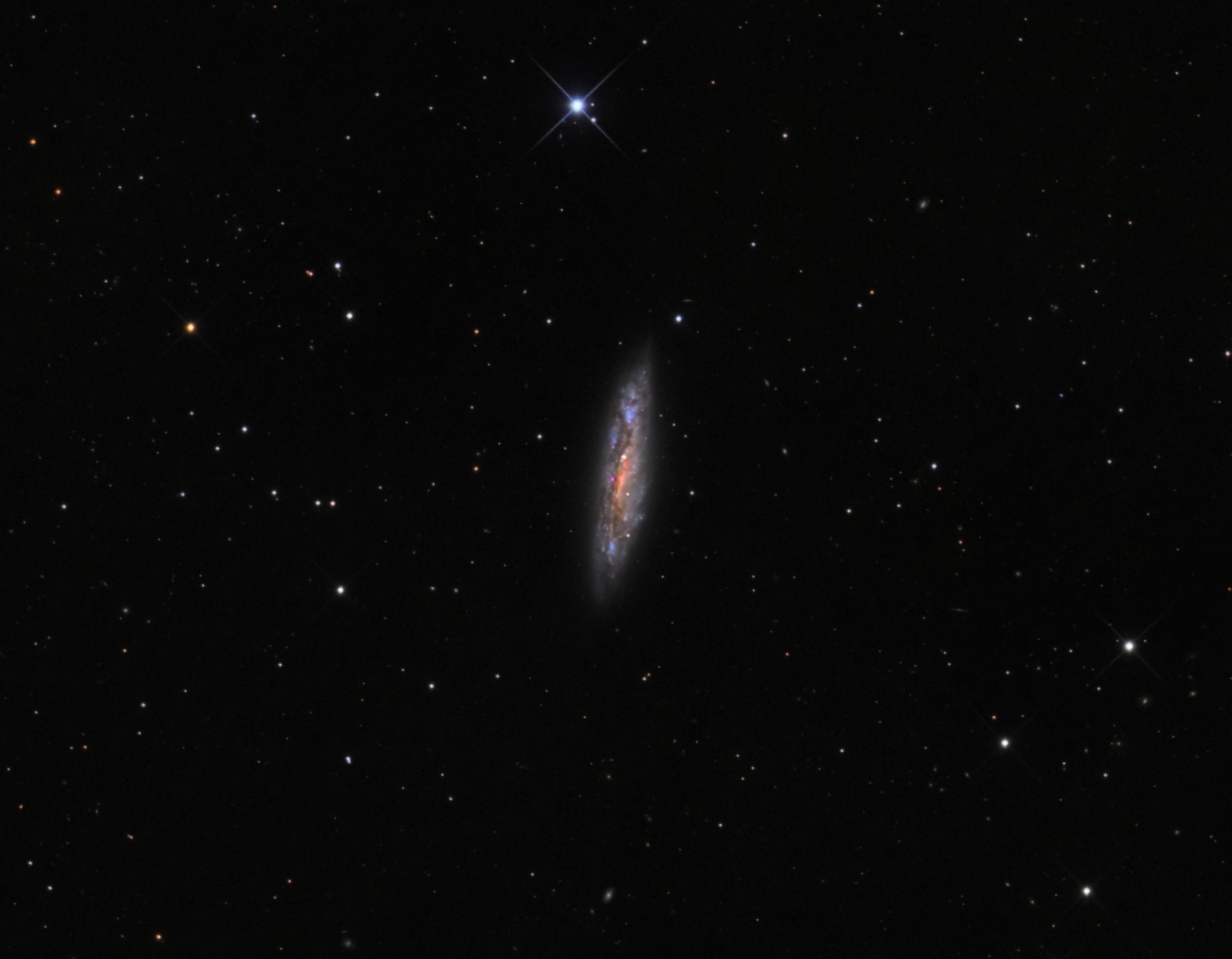M108, Barred Spiral Galaxy
Click image for full size version
April 23, 2015
M108 is a barred spiral galaxy in Ursa Major, and it lies near Merak, the lower-right star of the Big Dipper’s bowl. It lies about 46 million light years away. This is a very active galaxy, showing pink nebula, blue star clusters and many dark lanes throughout. There is a super-massive black hole at the centre of M108 that is estimated to have 24 million times the mass of the Sun. It is a member of the Ursa Major galaxy cluster, which in turn belongs to the Virgo Supercluster of galaxies. There are dozens of galaxies in this image that lie much further away than M108. Look for streaks and smudges that look different from the sharper stars.
Tekkies:
SBIG STL-11000M camera, Baader LRGB filters, 10″ f/6.8 ASA astrograph, Paramount MX. Guided with STL-11000’s external guider and 80 mm f/6 Stellar-Vue refractor. Acquistion, guiding and calibration done using Maxim-DL. Focusing with FocusMax. Automation with CCDCommander. Registration, integration and all processing in PixInsight. Shot from my SkyShed in Guelph, Ontario. No moon, good transparency and seeing throughout acquisition.
11x10m R, 9x10m G, 11x10m B and 41x10m L unbinned frames (total=12hr).
RGB:
Creation and cleanup: L, R, G and B masters were cropped. R, G and B were combined to make an RGB image which was processed with DBE and ColourCalibration.
Stretching: HistogramTransformation was applied to make a pleasing yet bright image.
Synthetic Luminance:
Creation and cleanup: The cropped L, R,G and B masters were combined using the ImageIntegration tool (average, additive with scaling, noise evaluation, iterative K-sigma / biweight midvariance, no pixel rejection). DBE was applied to neutralize the background.
Deconvolution: A star mask was made to use as a local deringing support. A copy of the image was stretched to use as a range mask. Deconvolution was applied (100 iterations, regularized Richardson-Lucy, external PSF made using DynamicPSF tool with about 20 stars).
Stretching: HistogramTransformation was applied to make a pleasing yet bright image.
Combining SynthL with RGB:
The luminance channel of the RGB was extracted, processed and then added back into the RGB image as follows:
1. Extract luminance from the RGB image.
2. Apply LinearFit using the SynthL channel as a reference.
3. Use ChannelCombination in Lab mode to replace the RGB’s luminance with the fitted luminance from step 2.
4. LRGBCombine was then used to make a SynthLRGB image.
Final Processing
Dynamic Range Adjustment and Stretching: SCNR was applied to remove green cast. TGVDenoise was applied in Lab mode with only luminance selected and using default settings, followed by HistogramStretch. A range mask was made that protected stars and background, and LocalHistogramEqualization was applied to the galaxy.
Star Shaping: At some point in the process some stars became slightly diamond shaped. To correct this, MorphologicalTransformation was applied using “Midpoint (Min+Max)/2” mode and a star mask to protect non-star regions of the image.
Final Steps: Background colour saturation was reduced slightly. A blurred range mask was made and used to increase colour saturation and contrast in the galaxy slightly. An UnsharpMask was applied to the galaxy followed by a light noise reduction with ACDNR on the entire image. A copy of the SynthL was processed with MultiscaleLinearTransformation with 4 layers and residual unchecked. Convolution (1 px) was applied to the result and this was used as a mask to boost colour saturation in the centre of the medium and small stars.
Image scale is about 1.1 arcsec per pixel for this camera / telescope combination.







Leave A Comment